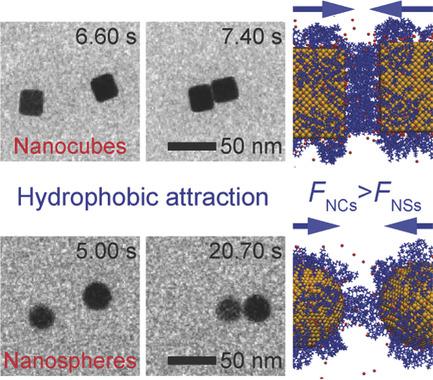当前位置:
X-MOL 学术
›
Adv. Mater.
›
论文详情
Our official English website, www.x-mol.net, welcomes your
feedback! (Note: you will need to create a separate account there.)
Nanoparticle Interactions Guided by Shape‐Dependent Hydrophobic Forces
Advanced Materials ( IF 27.4 ) Pub Date : 2018-03-14 , DOI: 10.1002/adma.201707077 Shu Fen Tan 1, 2, 3 , Sanoj Raj 4 , Geeta Bisht 1, 2 , Harshini V. Annadata 5 , Christian A. Nijhuis 3, 5, 6 , Petr Král 4, 7 , Utkur Mirsaidov 1, 2, 3, 6
Advanced Materials ( IF 27.4 ) Pub Date : 2018-03-14 , DOI: 10.1002/adma.201707077 Shu Fen Tan 1, 2, 3 , Sanoj Raj 4 , Geeta Bisht 1, 2 , Harshini V. Annadata 5 , Christian A. Nijhuis 3, 5, 6 , Petr Král 4, 7 , Utkur Mirsaidov 1, 2, 3, 6
Affiliation

|
Self‐assembly of solvated nanoparticles (NPs) is governed by numerous competing interactions. However, relatively little is known about the time‐dependent mechanisms through which these interactions enable and guide the nanoparticle self‐assembly process. Here, using in situ transmission electron microscopy imaging combined with atomistic modeling, it is shown that the forces governing the self‐assembly of hydrophobic nanoparticles change with the nanoparticle shapes. By comparing how gold nanospheres, nanocubes, nanorods, and nanobipyramids assemble, it is shown that the strength of the hydrophobic interactions depends on the overlap of the hydrophobic regions of the interacting nanoparticle surfaces determined by the nanoparticle shapes. Specifically, this study reveals that, in contrast to spherical nanoparticles, where van der Waals forces play an important role, hydrophobic interactions can be more relevant for nanocubes with flat side faces, where an oriented attachment between the nanocubes is promoted by these interactions. The attachment of nanocubes is observed to proceed in two distinct pathways: nanocubes either: (i) prealign their faces before the attachment, or (ii) first connect through a misaligned (edge‐to‐edge) attachment, followed by a postattachment alignment of their faces. These results have important implications for understanding the interaction dynamics of NPs and provide the framework for the design of future self‐assembled nanomaterials.
中文翻译:

形状依赖性疏水力指导的纳米粒子相互作用
溶剂化纳米颗粒(NPs)的自组装受众多竞争性相互作用的支配。但是,关于时间依赖性机制的了解很少,这些相互作用通过这些机制启用并指导纳米粒子的自组装过程。在此,结合使用原位透射电子显微镜成像和原子建模,表明控制疏水性纳米颗粒自组装的力随纳米颗粒形状而变化。通过比较金纳米球,纳米立方体,纳米棒和纳米双锥体的组装方式,表明疏水相互作用的强度取决于相互作用的纳米颗粒表面的疏水区域的重叠,该重叠区域由纳米颗粒的形状决定。具体而言,这项研究表明,与球形纳米颗粒相比,在范德华力起重要作用的地方,疏水相互作用可能与侧面平坦的纳米立方体更相关,在纳米立方体之间,这些相互作用促进了定向取向的附着。观察到纳米立方体的附着以两种不同的方式进行:纳米立方体:(i)在附着之前预先对齐其面部,或(ii)首先通过未对准的(边缘到边缘)附着进行连接,然后进行附着后对齐他们的脸。这些结果对于理解纳米粒子的相互作用动力学具有重要意义,并为未来自组装纳米材料的设计提供了框架。观察到纳米立方体的附着以两种不同的方式进行:纳米立方体:(i)在附着之前预先对齐其面部,或(ii)首先通过未对准的(边缘到边缘)附着进行连接,然后进行附着后对齐他们的脸。这些结果对于理解纳米粒子的相互作用动力学具有重要意义,并为未来自组装纳米材料的设计提供了框架。观察到纳米立方体的附着以两种不同的方式进行:纳米立方体:(i)在附着之前预先对齐其面部,或(ii)首先通过未对准的(边缘到边缘)附着进行连接,然后进行附着后对齐他们的脸。这些结果对于理解纳米粒子的相互作用动力学具有重要意义,并为未来自组装纳米材料的设计提供了框架。
更新日期:2018-03-14
中文翻译:

形状依赖性疏水力指导的纳米粒子相互作用
溶剂化纳米颗粒(NPs)的自组装受众多竞争性相互作用的支配。但是,关于时间依赖性机制的了解很少,这些相互作用通过这些机制启用并指导纳米粒子的自组装过程。在此,结合使用原位透射电子显微镜成像和原子建模,表明控制疏水性纳米颗粒自组装的力随纳米颗粒形状而变化。通过比较金纳米球,纳米立方体,纳米棒和纳米双锥体的组装方式,表明疏水相互作用的强度取决于相互作用的纳米颗粒表面的疏水区域的重叠,该重叠区域由纳米颗粒的形状决定。具体而言,这项研究表明,与球形纳米颗粒相比,在范德华力起重要作用的地方,疏水相互作用可能与侧面平坦的纳米立方体更相关,在纳米立方体之间,这些相互作用促进了定向取向的附着。观察到纳米立方体的附着以两种不同的方式进行:纳米立方体:(i)在附着之前预先对齐其面部,或(ii)首先通过未对准的(边缘到边缘)附着进行连接,然后进行附着后对齐他们的脸。这些结果对于理解纳米粒子的相互作用动力学具有重要意义,并为未来自组装纳米材料的设计提供了框架。观察到纳米立方体的附着以两种不同的方式进行:纳米立方体:(i)在附着之前预先对齐其面部,或(ii)首先通过未对准的(边缘到边缘)附着进行连接,然后进行附着后对齐他们的脸。这些结果对于理解纳米粒子的相互作用动力学具有重要意义,并为未来自组装纳米材料的设计提供了框架。观察到纳米立方体的附着以两种不同的方式进行:纳米立方体:(i)在附着之前预先对齐其面部,或(ii)首先通过未对准的(边缘到边缘)附着进行连接,然后进行附着后对齐他们的脸。这些结果对于理解纳米粒子的相互作用动力学具有重要意义,并为未来自组装纳米材料的设计提供了框架。











































 京公网安备 11010802027423号
京公网安备 11010802027423号